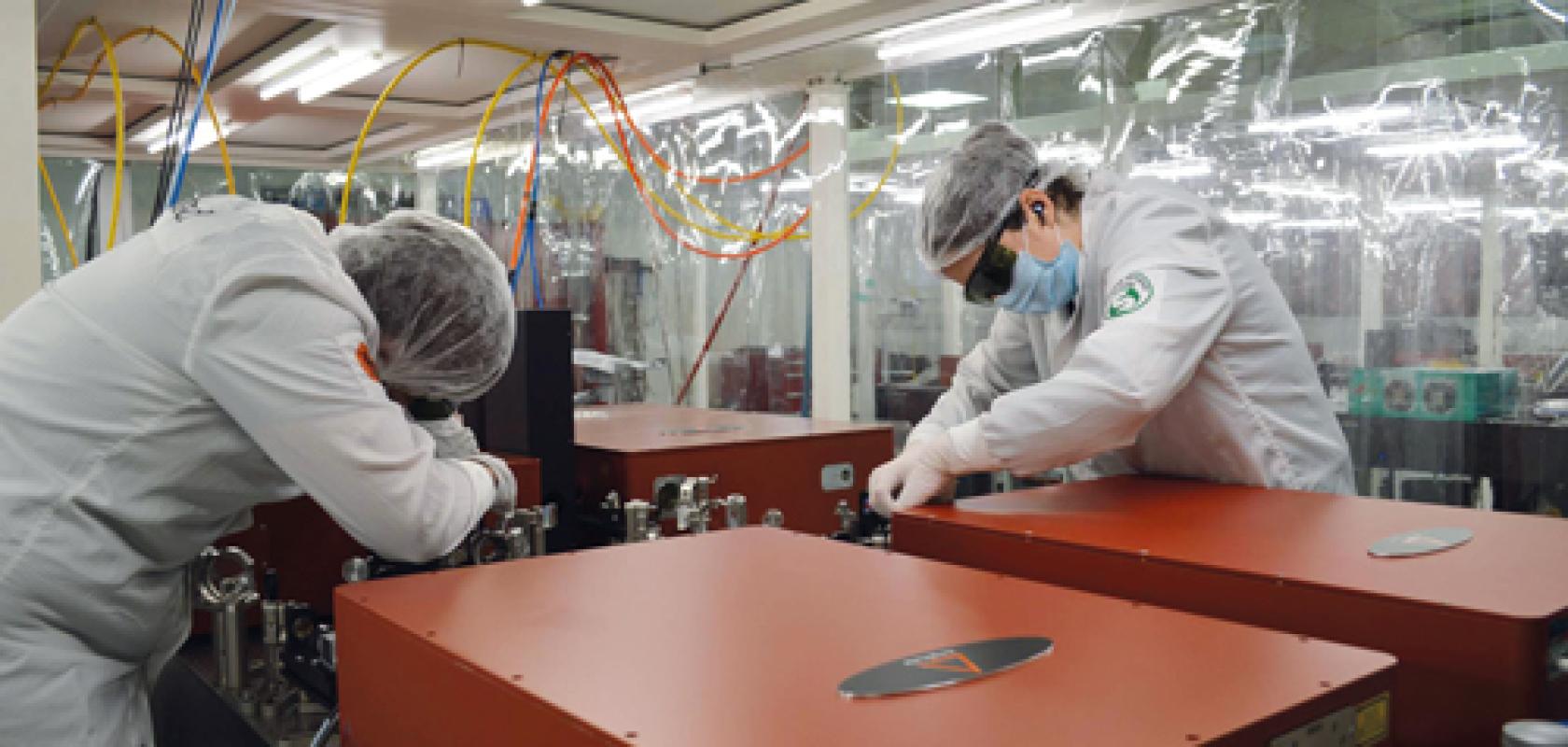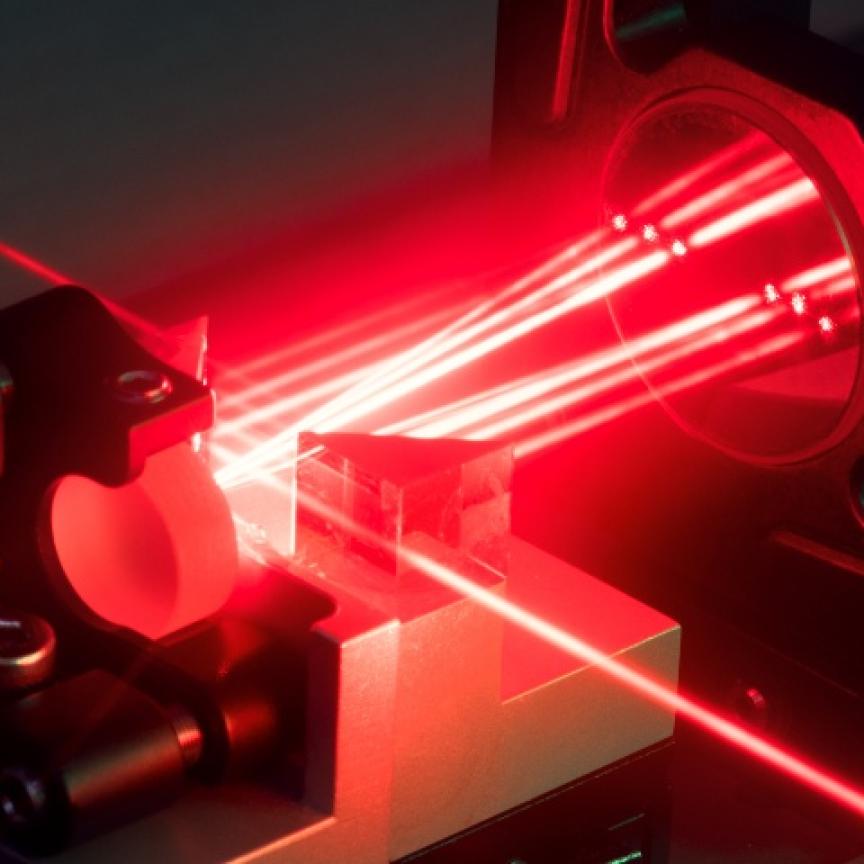In the battle to give people the longest, healthiest lives possible, cancer is one of our oldest foes, with some Egyptian mummies showing signs of bone cancer. The US government even declared war on cancer in 1971, and called for a ‘moonshot’ to end cancer as we know it in 2006. The resulting intensive medical effort has made many cancers treatable today. Yet modern populations are getting older on average, and older people’s cells are exposed to more factors that can make them mutate and become cancerous.
As such, there are still significant benefits to gain from more successful cancer treatment, according to Jonathan Shephard, from Heriot-Watt University in Edinburgh. His team is working on developing ultrafast lasers for cancer surgery, removing cancerous tissue with higher precision than conventional lasers, and without damaging surrounding tissue. ‘In the duration of the pulse, a few picoseconds, there isn’t sufficient time for heat to diffuse to the surrounding regions, as is the case for longer pulsed nanosecond or continuous wave lasers,’ Shephard said.
Today, ultrafast lasers are already routinely used in eye surgery. Yet there are challenges in deploying them elsewhere in medicine, which means they are not widespread.
Researchers like Shephard are looking at ways to overcome the technical obstacles to gaining their benefit. In cancer treatment, the advantages include reduced need for rehabilitation and supportive services, making it easier for patients to return to normal lives.
‘The improvement in the precision at which cancers can be removed will reduce the risk of complications,’ Shephard said. It would also remove cancers more completely, reducing recurrence rates and the resulting personal and financial costs.
One supplier of ultrafast femtosecond pulse duration lasers for ophthalmic surgery applications is Spectra-Physics, a brand of MKS Instruments, headquartered in Massachusetts. Herman Chui, MKS senior director of marketing, highlighted the general benefit of laser-based procedures compared to surgery using a scalpel: ‘If you get a better patient outcome, that can save you from healthcare costs.’
The other main medical application for Spectra-Physics’ ultrafast lasers is making implantable devices such as stents and catheters. ‘If you’re putting something in the body, you need the highest-quality surfaces on these devices,’ Chui explained. ‘By using ultrashort pulse lasers, you can achieve that.

‘You’re not necessarily limited in power or energy, and you may look at different wavelengths. For example, some of the biodegradable materials react better with green wavelengths versus infrared wavelengths. There is less thermal impact, shallower absorption depth, and you can get a better cut quality in those materials without melting.’
Spectra-Physics supplies lasers to ophthalmic surgery instrument producers. ‘We have many thousands of lasers deployed for this application,’ Chui said. That includes doing research to improve femtosecond lasers for eye surgery applications, taking great time and care to develop customer-specific products. Design changes tend to bring major advances, because medical instruments require approval from regulators such as the US Food and Drug Administration. Only major changes make it worth going through this process.
Finding the right target
Improvements typically involve parameters other than power, Chui explained. ‘The eye can only take so much power,’ he said. ‘It’s not like if you had more power, you could do more surgeries. It’s different than manufacturing, where if you have more power, you can manufacture more smartphones. Short pulse length is important but some of it is reliability, cost of ownership, size. It’s got to go into a doctor’s office, so it’s got to work all the time.’
Penetration of ultrafast lasers into ophthalmic surgery comes because the pupil is transparent, allowing access to the inside of the eye with light. However the tissues being operated on are also delicate, Chui stressed. ‘In a lot of other applications it’s okay to use a cruder laser to do a cut, and that has no implications,’ he said. ‘Or you may want some heat for cauterisation, if you’re cutting an area that has blood vessels.
‘And of course, ultrafast lasers are more expensive, so if you don’t need to use them, then you wouldn’t.’
Internal surgery also needs fibres to deliver the light, which is more complex and expensive with ultrashort pulse lasers, Chui added.
French femtosecond laser maker Amplitude is another supplier to ophthalmic surgery instrument producers. François Guillot, segment line manager for ophthalmology, said: ‘The main benefit lies in the fact that many medical procedures can simply not be done without femto.’
Antoine Courjaud, Amplitude’s product line manager, explained that there is an unmet need in glaucoma that such products may help resolve.
‘Ultrafast lasers allow a new generation of secondary sources that can compete with the standard sources in different fields, from x-ray radiography and therapy to proton therapy,’ he said.
Proton therapy allows for high-energy beams to be targeted at, and kill cancerous tissue, more precisely than x-ray radiotherapy is able to.
Amplitude sells ytterbium femtosecond lasers into industries including ophthalmology. It also has an established titanium-doped sapphire ultrafast laser portfolio, which can reach petawatt levels, with modest peak power for micromachining and surgery applications. It has also introduced a modular portfolio called Magma that provides high peak power up to terawatt levels, as well as high average power, up to 1kW.
Amplitude supplied a femtosecond titanium-doped sapphire laser with nearly a petawatt peak power to Helmholtz-Zentrum Dresden-Rossendorf (HZDR) in Germany to research proton therapy. The approach needs high power lasers that accelerate electrons, firing them into a plasma, where the electrons’ energy transfers to protons. The HZDR system is ‘producing protons, but still there is some work to be done on the characteristics of these protons,’ Courjaud said.
Closing in on cancer
Together with research centre Alphanov, in Talence, France, Amplitude is also developing a high power ultrafast laser that powers a secondary x-ray source. In this case they produce x-rays by accelerating electrons into a solid target. ‘The goal is to achieve a high brightness, high flux hard x-ray source dedicated to breast imaging,’ Courjaud explained. ‘The key optical considerations are peak power for conversion efficiency, and average power for the flux of the x-ray source. Since the source is inherently small, it naturally results in high brightness, which is the main interest of the laser-based x-ray source. Additionally, the x-ray source is naturally pulsed and ultrashort, which is of interest for moving objects or dynamic studies.’ After several years of work, the system produces x-ray images, Courjaud added, and is close to being used in breast screening tests. ‘We are now improving the characteristics of the X-ray source, through the conversion process and upgrading the laser source.’
Yet for direct use of ultrafast lasers in cancer surgery, Shephard agreed with Chui that fibre delivery is a key limitation. ‘Existing endoscopic surgical laser systems are restricted and cannot deliver such high peak power pulses with the flexibility required for precise, minimally invasive, procedures,’ he added. ‘With femtosecond laser surgery, the process speed is relatively slow and is impractical for appreciable tissue removal.’
Shephard’s team at Heriot-Watt is therefore focussing on lower picosecond pulse rates, for which robust lasers are readily available today. They combine the precision and lack of thermal damage that femtosecond systems attain, but can remove tissue much faster.
Shephard and his colleagues have therefore developed hollow core fibres for picosecond lasers in this application. They are mechanically and chemically robust, biocompatible, with very low sensitivity to bending, he said.
‘Hollow core fibres allow single mode delivery of the high peak power pulses, which enables tight focussing of the beam, in the order of 10µm, and hence giving a small focal volume within which the tissue ablation occurs,’ Shephard said. ‘The process is governed by non-linear absorption, so it is wavelength independent, which allows ablation of a wide range of tissues.’
Using a colorectal cancer tissue model, the Heriot-Watt team has safely and accurately removed small polyps with surgical precision.
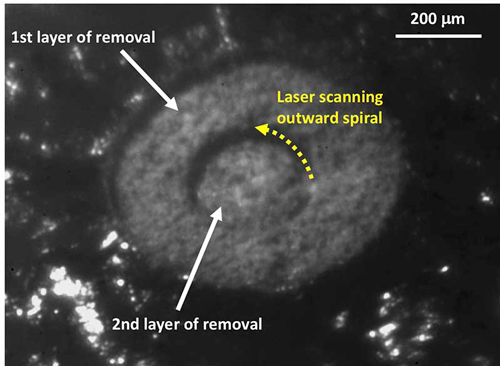
By adjusting the pulse energy and rapidly scanning the laser across the tissue using a layer-by-layer, the Heriot Watt University team was able to control the depth of removal approach to tens of micrometres per layer
‘By adjusting the pulse energy and rapidly scanning the laser across the tissue using a layer-by-layer, we were able to control the depth of removal approach to tens of micrometres per layer,’ Shephard said. ‘Histopathology confirmed the heat affected zone was minimised to below 50µm. This represents an order of magnitude improvement in precision. In the brain, for example, loss of even microscopic amounts of tissue can seriously affect function and quality of life.’
Shephard is ‘confident that we can use this process in many areas where the disease infiltrates vital organs.’
New colours shine through
Meanwhile, Goutam Samanta’s research group at the Physical Research Laboratory in Ahmedabad, India, is addressing other medical applications by extending the wavelengths available to femtosecond lasers.
Long pulse tunable dye lasers can be used in dermatology to remove port-wine stain (PWS) birthmarks, explained team member Anirban Ghosh.
However, whereas existing instruments can damage the skin being treated, yellow femtosecond lasers should have optimal properties for this application.
‘Even 60 years since the first demonstration of lasers, we only have a handful of commercially available lasers with selective wavelength coverage across the electromagnetic spectrum,’ said Ghosh. ‘This is mainly due to the unavailability of suitable laser gain media.’
Commercial yellow lasers do not exist, even though bulky and inefficient copper vapour lasers and dye lasers and optical parametric oscillators have been used successfully. Each of these suffers drawbacks of low average power, lack of adequate spatial beam profile, limited or no wavelength tunability, and broad output pulses.
By contrast, the Physical Research Laboratory has demonstrated a ‘relatively easy and straightforward system architecture to generate high power, high repetition rate ultrafast tuneable solid-state laser systems in the yellow wavelength range’, Ghosh said.
‘We developed a compact source of high power, tunable, ultrafast yellow radiation using the single-pass fourth-harmonic generation of a mid-IR laser in two-stage frequency-doubling processes.
‘We have frequency-doubled the ultrafast mid-IR laser at a central wavelength of 2,360nm in two different nonlinear crystals and used simple optical components available in any standard optics laboratory to achieve high power, tunable, ultrafast yellow laser source.
‘The laser could provide us a maximum output average power over 1W with 130fs pulses at a repetition rate of 80MHz, with an outstanding spatial beam profile,’ Ghosh continued. ‘We can also tune the laser across the wavelength range from 570 to 596nm. We have also observed excellent power stability over a long duration, opening up the possibility of having a handy source for various applications.’
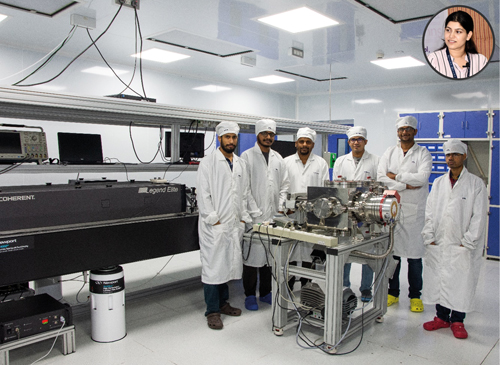
Members of Professor Goutam Samanta’s research group at the Photonic Sciences Lab, Physical Research Laboratory, in Ahmedabad, India
The ultrashort pulse length and the yellow colour are the two main parameters for medical applications, Ghosh added, but beam profile is also important.
‘Focusing the laser beams to the diffraction limit to reduce the collateral damage of the tissues requires the source to have a good spatial beam quality,’ he said.
‘For example, in the case of the therapeutic effects of macular photocoagulation, the extent of thermal injury to a tissue is proportional to the magnitude and duration of the temperature increase that it experiences. Temperature rise at the periphery of a photocoagulation lesion may be lower than that at its centre, because of heat conduction or lack of a uniform beam profile. Thus, it is good to use an ultrafast pulse laser with an excellent beam profile, in such applications.’
To realise the benefits of such advances will likely take the involvement of companies like Amplitude, which specialises in making the switch from research to industrialisation, explained Guillot.
‘If we look at the X-pulse project, in theory, we know how to do it,’ he said.
‘What we’re unable to do today is to produce 100 machines that could be used on a daily basis. If we want to have a medical application, we need to be able to produce something industrially, otherwise it remains a very niche market.’ Guillot is optimistic that the systems ultimately in development will make that transition.
‘Let us hope that tomorrow these ultrafast lasers will also contribute to the benefit of humankind,’ he said.
With laser systems pushing the boundaries of high power and performance, it is no surprise the dedicated team at Hilase have managed to break new ground, using optics supplied by Manx Precision Optics.
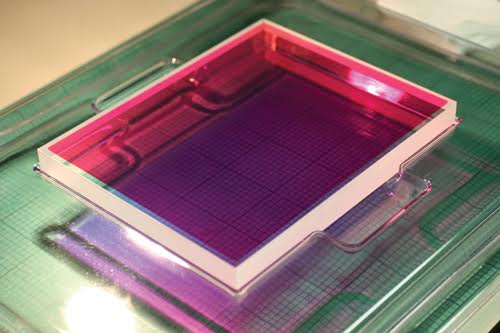
High LIDT optic manufactured by Manx Precision Optics
In January a team of scientists at Hilase, led by Dr Martin Divoký, beat the previous world record for average power output from a high energy laser (which they set themselves in 2016). The team, in partnership with the Science and Technology Facilities Council’s (STFC) Central Laser Facility, operated the BIVOJ laser system for an hour at a pulse energy in excess of 145J in 10ns pulses at a repetition rate of 10Hz at 1030nm.
The BIVOJ laser system is a pulsed nanosecond diode-pumped solid-state laser (DPSSL) developed at the Central Laser Facility, and classifies as a powerful kW laser. The system uses cryogenic cooling technology and the extraordinary feat achieved by the team is a huge milestone in the development of high-power laser systems.
Key to the facility is the dedication and professionalism of the team behind it. Dr Martin Divoký’s highly skilled and passionate team adheres strongly to cleanliness procedures, and their knowledge and experience ensures that all the featured optics are carefully mounted and aligned.
Part of the success of the record-breaking BIVOJ laser system is down to the optical components used, supplied from partners Manx Precision Optics, in the Isle of Man, as well as Crytur, in the Czech Republic.
Manx Precision Optics (MPO)have been working with STFC since MPO’s inauguration in 2013, and with Hilase since 2017, being trusted by both to provide high quality, high LIDT optical components. In working with Hilase, MPO have developed coatings which have a Laser-induced Damage Threshold (LIDT) close to the physical limits of the BIVOJ laser.

BIVOJ laser system
Achieving high LIDT
When designing an optical component for a sustained high-power beam such as the BIVOJ system, the optical coating is the primary factor in the success. Manx Precision Optics has years of experience in high energy optics, and understands that there are a number of factors that are highly important in optical performance.
Chris Bridle, MPO's large optic and key account manager, explained: 'It’s not just about selecting materials, obviously these are critical, you need to select materials that can withstand the Laser-induced Damage Threshold, but also the process parameters are all critical. The vacuum environment, temperature, evaporation rates and background gasses all have an important role to play, and process repeatability is key’
When designing the coating for the optics in the BIVOJ, Manx Precision Optics were mindful of how the system was to be used, and worked within those considerations to design a coating that could withstand the laser damage, without negatively impacting other areas of the optical configuration.
Coating design was not the only factor that Manx Precision Optics had to consider, as any surface errors can significantly impact the LIDT of an optic. MPO’s grinding and polishing processes are designed to remove sub surface damage and promote a high quality, low-surface roughness, contamination-free substrate.
‘Our after-coating flatness is something that we take great pride in’ says Dr Helmut Kessler, the firm's managing director. MPO’s superior after coating flatness ensures beam quality is maintained throughout the chain of optics, which ensures a superb output performance.
Partnership is paramount
The success of Dr Divoký and the Hilase team shows the importance of partnership within the photonics community. The BIVOJ laser system used to break the record was initially developed at STFC’s Central Laser Facility, and it was a joint team of Hilase and STFC scientists who set the previous record.
While not only a record-breaking achievement, the success of the joint project provides invaluable data and will feed into STFC’s development of the Extreme Photonics Application Centre, to be constructed at STFC Harwell. With the organisation also loaning another laser to the European XFEL system in Germany, co-operation remains strong in the European photonics community.
In working with Manx Precision Optics and Crytur on the world record achievement, Hilase has shown the power of strong international co-operation with trusted suppliers who can offer high LIDT, high quality optical components.
Dr Divoký commented on the relationship between the facility and Manx Precision Optics. ‘We started looking for durable optics for our new high-energy high-average power laser in 2017, when most of the mirrors in the laser burned in just under five minutes. We approached several manufactures, MPO being one of them. Over the years I valued their open approach to share information about the coating process with us. This openness on both sides bore fruit in a couple of years, when the first mirror with high enough LIDT was made available to us. The mirrors were one of several key elements needed to push the limit of the laser to 1.45kW in 145J @ 10Hz’
To find out more about and other ways Manx Precision Optics can help you click here.

